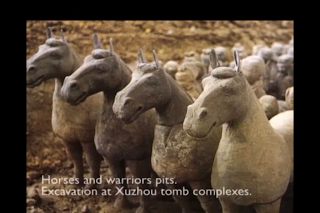So, last week I went to the Fitzwilliam Museum, Cambridge, to see this gorgeous exhibition, The Search for Immortality: Tomb Treasures of Han China. (The virtual exhibition at that link is well worth having a look at.) The Han Dynasty existed between 206BC and 220AD; the things in this exhibition were excavated from the tombs of the elite and royal classes, which were replicas of their own palaces complete with everything they could need in the afterlife, including their servants. The Han Emperors were buried in what is now Xi'an (the site of the Terracotta Army), but those tombs have been looted or lost (and the main tomb site in Xi'an, where the warriors are, can't be excavated because apparently it is protected by a lake of mercury.) The objects in the exhibition come from the tombs of the Kings and Queens of Chu, located in Xuzhou, the home of the Han family. They contained hundreds of intricate, decorated pieces of goldwork, jade, bronze, and pottery to prepare the body for the afterlife; these pieces have never been displayed all together before. It's astonishing and fascinating. It's also kind of heartbreaking to think of these beautiful things being jealously walled up in a grave, but at the same time, that's the only reason they've been preserved and not lost.
In the Museum Director Timothy Potts's very interesting podcast about this exhibition, he explains that they kept the exhibition rooms very dim on purpose and spotlighted the objects to create a tomblike feel and a "dramatic experience". It makes for a very beautiful and intriguing space.
Along with a bunch of postcards (below), I bought this little guy! It's a replica of a turtle seal from the exhibition, and way heavier than it looks. The name on it is Liu Zhu, who was the sixth king of Chu.
The exhibition is running until 11th November. Way more images below. Some are from the podcast and some are postcards from the museum shop. All images copyright the Fitzwilliam Museum, I guess?
I've actually been to Xi'an and seen the Terracotta Army (or what has been re-assembled of it so far, since it's all rubble when it's dug up), which sort of spoiled me for these pottery figurines, since the Army is life-sized and these are only a foot or so, but they still are beautiful pieces of work. Originally they would all have carried wooden weapons and been painted bright colours; they had a few that had retained the paint, but I actually think they look much more elegant without. (When they began to excavate the Terracotta Warriors, the paint began to peel in fifteen seconds when it hit the air and had completely disintegrated in four minutes.) Like the Terracotta Warriors, every man and horse is different and has its own distinguishing features. This is so they will all have individual spirits that will animate in the afterlife (I think?)
I love these! A prancing black and gold tiger and a jolly reclining stone lion, like the one that Edmund draws glasses on in The Lion, The Witch and The Wardrobe.
The goldwork objects are some of the most impressive and beautiful in the exhibition. In reality these two pieces are tiny. The turtle is similar to the original seal of my replica. It's amazing how after 2000 years you can still see the ink in the stamp part.
Kitchen things, in case you get hungry after you're dead. The solid jade beaker you can just see underneath and behind the top left vase was one of my favourite pieces.

They apparently liked really chunky jewellery on their mistresses. I love jade, and while a lot of it had calcified badly, there were some incredible carved things. They believed that jade could ward off evil spirits and things, which is why the most important people, the kings, had these:
These jade suits are exactly what they look and sound like; full body armour made of hundreds of tiny plaques of jade sewn together, in which the body was dressed for burial. Presumably this was supposed to help you make it to the afterlife all in one piece. The top one with the most red belonged to a rival king with whom the neighbouring Han kings had an uneasy and sometimes volatile relationship (drama!). They're kind of ugly and hilarious, but technically and culturally fascinating.
You can visit this exhibition at the Fitzwilliam, Cambridge until November 11th, or check out the virtual exhibition online here.




















No comments:
Post a Comment